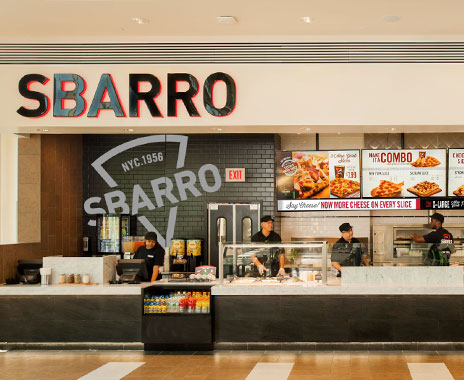When David Karam took the reins of Sbarro in 2013, he found himself with a floundering brand. Fresh off a bankruptcy, the then–New York –based brand was still beleaguered by a large amount of debt and was grasping for stronger sales.
There seemed to be only one way forward.
“The logical path was ultimately to rebrand the concept as primarily an authentic, freshly prepared, New York pizzeria that ultimately could compete on the streets with the likes of Domino’s and Papa John’s,” Karam says.
Fast-forward two and a half years and Sbarro is hardly recognizable. After declaring bankruptcy a second time in March 2014 and closing about 175 stores, Sbarro emerged stronger and more streamlined, with the best traffic performance it’s seen in nearly a decade, new unit growth, and positive sales throughout the system.
Aside from Sbarro’s signature New York–style pizza, nothing was off limits for a refresh. Its headquarters were moved to Columbus, Ohio, where Karam had cut his teeth as president of Wendy’s International from 2008 to 2011. A new logo ditched the red, white, and green Italian flag and lowercase, italic lettering in favor of a sleeker, all-caps, black print encircled by a simple red and green pizza slice. The brand also tweaked its recipes and reemphasized the quality of its pizza—dough made in-house daily, sauce made from San Marzano tomatoes, and whole-milk Mozzarella shredded in-house.
“The consumers’ IQ with food is getting more and more sophisticated. They’re paying a lot of attention to what they’re putting into their bodies,” says CMO Anne Pritz. She adds that high-quality ingredients have always set Sbarro apart from the competitors; now it is reemphasizing that quality given the elevation of consumer demand.
The boost in attention to menu quality coincides with a reduction in menu quantity. Karam says that when the company restructured in earnest, the leadership realized that Sbarro’s reputation as an Italian eatery had led to a proliferation of menu items beyond the core offerings of pizza and Stromboli.
“That may may have been more relevant in the ’70s and ’80s, but it really became less relevant in the last couple of decades as the consumer insisted upon and demanded more freshly prepared foods,” Karam says. “What sold at Sbarro was—and the way the consumer viewed that brand was—primarily pizza. … And yet the company continued to invest a lot of their operating focus on this broader line of Italian foods, like lasagna, chicken Parmesan, etc.”
This might sound like an all-too-familiar tale of a fast-food brand reinventing itself as a fast casual, but Karam says it is quite the opposite. Sbarro might be improving and promoting its quality, but the brand plans to stay squarely within the quick-service space. At a time when fast-casual pizza is booming and traditional delivery outfits like Domino’s are rebranding to include more menu items, Sbarro is taking the road less traveled.
The final aspect of this sizeable makeover is store design. In October, Sbarro will open its first-ever standalone store in the Clintonville neighborhood of Columbus.
“It’s not that Sbarro is looking to exit malls—really, nothing could be further from the truth,” Karam says. “It’s simply that we don’t want mall locations to represent the preponderance of all of our stores.” He adds that of the 900 malls in the U.S., Sbarro has locations in roughly a third, leaving ample room for mall expansion.
The new location will feature indoor seating for 20, as well as an outside patio. It will also offer carryout and delivery services. Within the next six weeks, four additional standalone stores will debut in the Columbus area.
And while the brand doesn’t have a specific goal for standalone units outside of its home base, he estimates that five to 10 company-owned stores, as well as additional franchise restaurants, will open next year.
Sbarro will also remodel 25 mall locations by the end of the year and 40 in 2016. The updated designs will include new menuboards, signage, and a modified store design that brings prep to the front, in view of customers.










